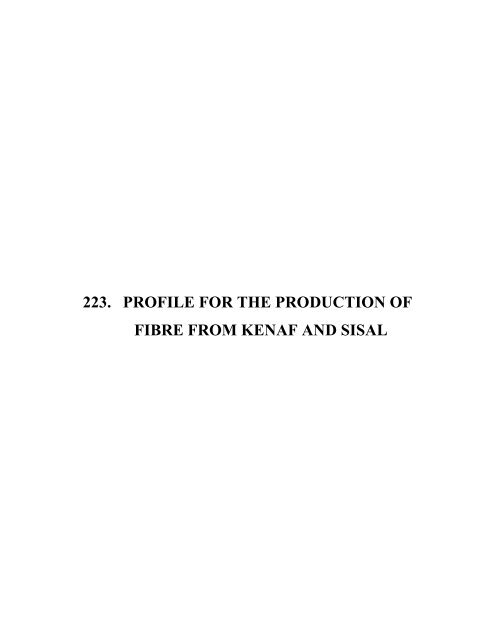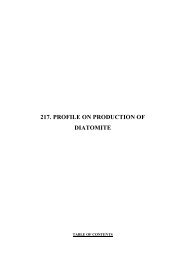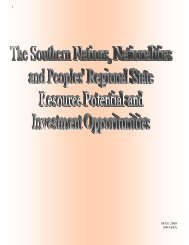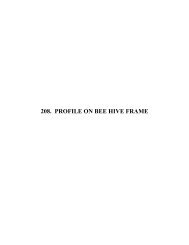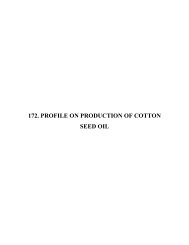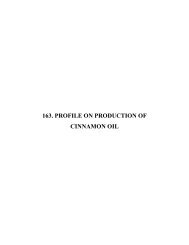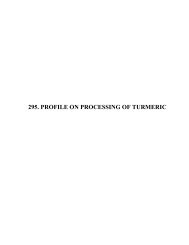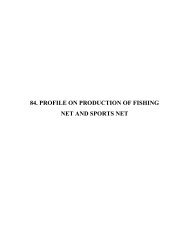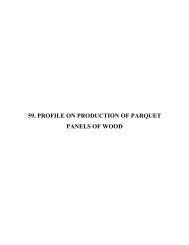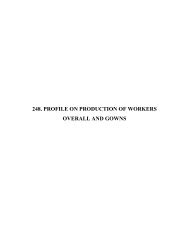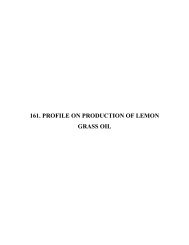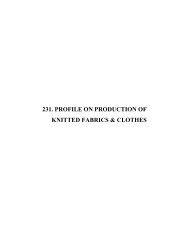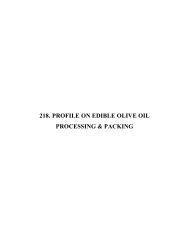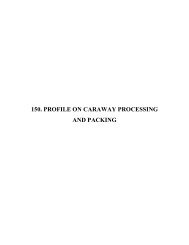Profile for the Production of Fibre From Kenaf and Sisal - SNNPR ...
Profile for the Production of Fibre From Kenaf and Sisal - SNNPR ...
Profile for the Production of Fibre From Kenaf and Sisal - SNNPR ...
You also want an ePaper? Increase the reach of your titles
YUMPU automatically turns print PDFs into web optimized ePapers that Google loves.
223. PROFILE FOR THE PRODUCTION OFFIBRE FROM KENAF AND SISAL
223-2TABLE OF CONTENTSPAGEI. SUMMARY 223-3II. PRODUCT DESCRIPTION & APPLICATION 223-3III. MARKET STUDY AND PLANT CAPACITY 223-4A. MARKET STUDY 223-4B. PLANT CAPACITY & PRODUCTION PROGRAMME 223-7IV. RAW MATERIALS AND INPUTS 223-8A. RAW & AUXILIARY MATERIALS 223-9B. UTILITIES 223-9V. TECHNOLOGY & ENGINEERING 223-10A. TECHNOLOGY 223-11B. ENGINEERING 223-11VI. MANPOWER & TRAINING REQUIREMENT 223-11A. MANPOWER REQUIREMENT 223-12B. TRAINING REQUIREMENT 223-12VII. FINANCIAL ANALYSIS 223-13A. TOTAL INITIAL INVESTMENT COST 223-13B. PRODUCTION COST 223-14C. FINANCIAL EVALUATION 223-15D. ECONOMIC BENEFITS 223-16
223-3I. SUMMARYThis pr<strong>of</strong>ile envisages <strong>the</strong> establishment <strong>of</strong> a plant <strong>for</strong> <strong>the</strong> production <strong>of</strong> fibre from kenaf<strong>and</strong> sisal with a capacity <strong>of</strong> 10,000 tones per annum.The present dem<strong>and</strong> <strong>for</strong> <strong>the</strong> proposed product is estimated at 13,571 tones per annum.The dem<strong>and</strong> is expected to reach 19,930 tones by <strong>the</strong> year 2020.The plant will create employment opportunities <strong>for</strong> 70 persons.The total investment requirement is estimated at about Birr 8.91 million, out <strong>of</strong> whichBirr 687,500 is required <strong>for</strong> plant <strong>and</strong> machinery.The project is financially viable with an internal rate <strong>of</strong> return (IRR) <strong>of</strong> 30 % <strong>and</strong> a netpresent value (NPV) <strong>of</strong> Birr 8.75 million discounted at 8.5%.II.PRODUCT DESCRIPTION AND APPLICATION<strong>Sisal</strong> <strong>and</strong> kenaf fibre is an important raw material required <strong>for</strong> production <strong>of</strong> ropes, cords,door mats, industrial matting <strong>and</strong> various articles like shopping bags, coasters etc. Thedem<strong>and</strong> <strong>for</strong> <strong>the</strong> product is met by local production <strong>and</strong> import.Extraction <strong>of</strong> fibre from sisal leaves <strong>and</strong> kenaf tree is largely done by retting process.The production process is free from any negative impact to <strong>the</strong> environment.
223-4III.MARKET STUDY AND PLANT CAPACITYA. MARKET STUDY1. Current Dem<strong>and</strong> <strong>and</strong> SupplyThe current local industrial suppliers <strong>of</strong> sisal fiber are Meher <strong>and</strong> Ethiopia FiberFactories. Meher Fiber produces sisal fiber <strong>and</strong> ropes <strong>and</strong> clothing <strong>for</strong> variousapplications. There is no disaggregated data on production <strong>of</strong> sisal fiber. However sisalfiber <strong>and</strong> twin ropes are complementary to sisal sacks. The dem<strong>and</strong> <strong>for</strong> sisal fiber <strong>and</strong>ropes on <strong>the</strong> o<strong>the</strong>r h<strong>and</strong>, can emerge from various sources. <strong>Sisal</strong> twin ropes can bedem<strong>and</strong>ed <strong>for</strong> rural <strong>and</strong> urban households. Rural household use twin ropes to controllivestock at home or in specific place. It can also be used in housing construction to tietoge<strong>the</strong>r.The fiber is used in water supply system to give strength <strong>and</strong> tight at joining parts. It isalso used in complementary with sacks to join toge<strong>the</strong>r tips, after products are filled in toit. <strong>SNNPR</strong>S is reach in livestock <strong>and</strong> <strong>the</strong> dem<strong>and</strong> <strong>for</strong> twin rope to control livestock, <strong>for</strong>binding materials <strong>and</strong> to load goods on load animals is very high.In <strong>the</strong> absence <strong>of</strong> data on quantity <strong>of</strong> sisal fiber dem<strong>and</strong> <strong>and</strong> supply <strong>the</strong> followingassumption were used to estimate <strong>the</strong> current effective dem<strong>and</strong>. The assumption wasbased on <strong>the</strong> discussing held with experienced people <strong>and</strong> observation where everpossible.− There are 2,654,225 rural households in <strong>SNNPR</strong>S in 2006.− According to <strong>SNNPR</strong>S Regional Bureau <strong>of</strong> Finance <strong>and</strong> Economic Developmentduring <strong>the</strong> period 2000 – 2004 <strong>the</strong> average annual production <strong>of</strong> agriculturalproducts including cereals, pulses, oil seeds, vegetables, fruits, spices <strong>and</strong> root<strong>and</strong> tubers is 33,067,208 quintal which means about 33 million sacks arerequired annually to h<strong>and</strong>le agricultural products.
223-5− One kg <strong>of</strong> sisal fiber rope can be used to mend 10 pieces <strong>of</strong> sacks when filledwith products.− Each rural household in <strong>the</strong> Region will use at least 5 kg <strong>of</strong> sisal ropes perannum.Accordingly− For 30,000,000 pieces <strong>of</strong> sacks = 50,000,000 - 300,000 kgs10− For 2,654,225 house hold X 5kg sisal fiber consumption = 13,271,125 kgs− ∴Total dem<strong>and</strong> = 300 tones + 13,271 tones = 13,571 tones <strong>of</strong> sisal fiberaccordingly <strong>the</strong> current effective dem<strong>and</strong> <strong>for</strong> sisal <strong>and</strong> kenaf fiber in <strong>SNNPR</strong>Sis estimated at about 13,571 tones.2. Dem<strong>and</strong> ProjectionThe future dem<strong>and</strong> <strong>for</strong> sisal fiber is related to population growth which is 3% per annum.Accordingly <strong>the</strong> projected dem<strong>and</strong> is shown in Table 3.1
223-7that <strong>the</strong> envisaged plant will have market share with an annual production capacity <strong>of</strong>10,000 tones. <strong>Production</strong> shall be carried out in two shifts 16 hours a day, <strong>for</strong> 300 days ayear.2. <strong>Production</strong> Programme<strong>Production</strong> will start at lower capacity (75%) during <strong>the</strong> initial period <strong>of</strong> plant operationto give provisions <strong>for</strong> operational skill development <strong>and</strong> create adequate opportunity <strong>for</strong>establishing potential market out lets. Then production will rise to 85% <strong>and</strong> 100%during <strong>the</strong> second <strong>and</strong> third year, respectively. The production programme <strong>of</strong> <strong>the</strong> planttoge<strong>the</strong>r with percentage capacity utilization over <strong>the</strong> production building-up period isgiven in Table 3.2 below.Table 3.2PRODUCTION PROGRAMMEYear 1 2 3 <strong>and</strong> aboveCapacity utilization (%) 75 85 100<strong>Production</strong> (tone) 7500 8500 10,000IV.MATERIALS AND INPUTSA. RAW AND AUXILIARY MATERIALSThe basic raw materials <strong>for</strong> <strong>the</strong> production <strong>of</strong> sisal <strong>and</strong> kenaf fibers are sisal leaves <strong>and</strong>stems <strong>of</strong> kenaf plant. These raw materials are grown in <strong>SNNPR</strong>S, particularly in AwassaZuria,The fibrous materials expected to be extracted are 77.2% <strong>for</strong> sisal <strong>and</strong> about 66% <strong>for</strong>kenaf by weight. Thus, to produce 10,000 tons <strong>of</strong> sisal <strong>and</strong> kenaf fibers, <strong>the</strong> average rawmaterial requirement is estimated to be 13505 tons, assuming that 7500 tons <strong>of</strong> sisal fiber
223-8<strong>and</strong> 2500 tons <strong>of</strong> kenaf fibre will be annually produced. It is estimated that <strong>the</strong> raw sisalleave <strong>and</strong> kenaf stalk will cost Birr 1.75 per kg. Thus, <strong>the</strong> annual raw material cost at fullcapacity production is estimated to be Birr 23,633,750.B. UTILITIESElectricity <strong>and</strong> water are required in sisal <strong>and</strong> kenaf production, electricity is required <strong>for</strong>running production equipment <strong>and</strong> lighting purposes. Water is required <strong>for</strong> washing <strong>the</strong>fibres, <strong>for</strong> sanitation <strong>and</strong> human consumption. It is estimated that annual electricityconsumption will be 24,000 kWh, where as annual water consumption will be Birr 2000.Thus, <strong>the</strong> total expenditure on water <strong>and</strong> electricity will be Birr 13,376.V. TECHNOLOGY AND ENGINEERINGA. TECHNOLOGY1. <strong>Sisal</strong> <strong>Fibre</strong>The fibres are extracted from <strong>the</strong> leaves <strong>of</strong> <strong>the</strong> plant (Agave sisalana) normally grown in<strong>SNNPR</strong>S. The agaves have rosettes <strong>of</strong> fleshy leaves, usually long <strong>and</strong> narrow, whichgrow out from a central bud. As <strong>the</strong> leaves mature <strong>the</strong>y gradually spread out horizontally<strong>and</strong> are 1-2 meters long, 10-15 cms wide, with a thickness <strong>of</strong> about 6 mm at <strong>the</strong> centre.The fibres are embedded longitudinally in <strong>the</strong> leaves, <strong>and</strong> are most abundant near <strong>the</strong> leafsurfaces. The leaves contain about 90% moisture, but <strong>the</strong> fleshy pulp is very firm <strong>and</strong> <strong>the</strong>leaves are rigid. The fiber is removed when <strong>the</strong> leaves are cut because dry fibers adhereto <strong>the</strong> pulp. The fiber is removed by scraping away <strong>the</strong> pulpy material, generally by amechanical decortications process.In decortications, <strong>the</strong> leaves are fed through sets <strong>of</strong> fluted crushing rollers. The crushedleaves are held firmly at <strong>the</strong>ir centers <strong>and</strong> both ends are passed between pairs <strong>of</strong> metaldrums on which blades are mounted to scrape away <strong>the</strong> pulp, <strong>and</strong> <strong>the</strong> centers are scraped
223-10Table 5.1LIST OF PLANT MACHINERY AND EQUIPMENTNo. Description Qty Cost (‘000 Birr)LC FC TCA. <strong>Sisal</strong> <strong>Fibre</strong> <strong>Production</strong>1 Fluted crushing rollers (with motor 4 sets - 320 320& control panel)2 Metal drums (with mounted 4 paris - 80 80(blades) (Revolving)3 Washing basins (stainless steel) 2 pcs 20 - 204 Revolving metal drums (with 2 pcs - 50 50motor <strong>and</strong> control panel)5 Tables, h<strong>and</strong> tools, etc. Reqd. - 17.5B. <strong>Kenaf</strong> fibre production1 Cutting knife 10- 20 20sets2 Mechanical stripping device 5 sets - 15 153 Washing basin (stainless steel) 4 pcs 40 - 404 Tables, h<strong>and</strong> tools, etc. Reqd. - 15 15FOB price 60 517.50 577.50Freight, Insurance, customs, bank110 - 110chargesCIF l<strong>and</strong>ed cost 170 517.50 687.502. L<strong>and</strong>, Building <strong>and</strong> Civil WorksL<strong>and</strong> is required <strong>for</strong> factory building <strong>and</strong> <strong>for</strong> annex buildings that comprise <strong>of</strong> <strong>of</strong>fices,cafeteria, guard houses <strong>and</strong> buildings <strong>for</strong> utilities. Spare l<strong>and</strong> <strong>for</strong> future expansion is alsorequired. Thus, <strong>the</strong> total l<strong>and</strong> requirement is estimated to be 3000 m 2 . Of this built-uparea will be 1500 m 2 . At <strong>the</strong> rate <strong>of</strong> Birr 1.0 per m2 <strong>for</strong> a period <strong>of</strong> 80 years <strong>the</strong> total
223-11l<strong>and</strong> lease value will be Birr 240,000. For built-up area <strong>of</strong> 1500 m 2 , <strong>and</strong> at <strong>the</strong> rate <strong>of</strong> Birr2000 per m 2 , <strong>the</strong> total investment on buildings will be Birr 3 million. Thus, <strong>the</strong> total coston l<strong>and</strong>, buildings <strong>and</strong> civil works will be Birr 3.24 million.3. Proposed LocationLocation <strong>of</strong> a plant is determined on <strong>the</strong> basis <strong>of</strong> proximity to raw material, availability <strong>of</strong>infrastructure, <strong>and</strong> distance from potential market outlets. Moreover, consideration isgiven to fair distribution <strong>of</strong> projects among <strong>SNNPR</strong>S woredas. Accordingly, Hadiya,Sidama <strong>and</strong> Awassa Zurea are identified. The four woredas where kenaf <strong>and</strong> sisal plantgrow are Badawacho, Aleta Dale <strong>and</strong> Awassa Zuria. Of <strong>the</strong>se Badawacho woreda isselected. It is <strong>the</strong>re<strong>for</strong>e appropriate to establish <strong>the</strong> proposed fibre production plant inshone town.VI.MANPOWER AND TRAINING REQUIREMENTA. MANPOWER REQUIREMENTThe envisaged fibre production plant requires both administration staff <strong>and</strong> productionworkers. The details <strong>of</strong> manpower are shown in Table 6.1 below.B. TRAINING REQUIREMENTThe production <strong>of</strong> fibre from sisal leaves <strong>and</strong> kenaf plant does not require specializedtraining workers having experience in machinery operation in o<strong>the</strong>r factories <strong>and</strong> withqualification in technical studies from TVETS can h<strong>and</strong>le <strong>the</strong> production process.
223-12Table 6.1MANPOWER REQUIREMENTNo. Job Title Nos Monthly Annual SalarySalaryA. Administration1 Plant manager 1 2000 240002 Secretary 1 800 96003 Personnel <strong>of</strong>ficer 1 1000 120004 Accountant 1 1000 120005 Store keeper 1 750 90006 Sales man 1 750 90007 Cashier 1 600 72008 Driver 2 500 60009 Cleaner 2 250 300010 Messenger 2 350 420011 Guards 4 250 3000Sub total 17 - 99,000B. <strong>Production</strong>1 <strong>Production</strong> head 2 1200 288002 Mechanic / electrician 4 700 336003 Skilled operators 30 500 1800004 Unskilled labor 15 250 450005 <strong>Production</strong> clerk 2 500 12000Sub-total 53 - 299.400Workers benefit (25 % BS) - - 99,600Total 70 - 497,600
223-13VII. FINANCIAL ANALYSISThe financial analysis <strong>of</strong> <strong>the</strong> fiber from kenaf <strong>and</strong> sisal project is based on <strong>the</strong> datapresented in <strong>the</strong> previous chapters <strong>and</strong> <strong>the</strong> following assumptions:-Construction period1 yearSource <strong>of</strong> finance30 % equity70 % loanTax holidays3 yearsBank interest 8%Discount cash flow 8.5%Accounts receivable30 daysRaw material local30daysWork in progress5 daysFinished products30 daysCash in h<strong>and</strong>5 daysAccounts payable30 daysA. TOTAL INITIAL INVESTMENT COSTThe total investment cost <strong>of</strong> <strong>the</strong> project including working capital is estimated at Birr8.91 million, <strong>of</strong> which 29 per cent will be required in <strong>for</strong>eign currency.The major breakdown <strong>of</strong> <strong>the</strong> total initial investment cost is shown in Table 7.1.
223-14Table 7.1INITIAL INVESTMENT COSTSr.No.Cost ItemsTotal Cost(‘000 Birr)1 L<strong>and</strong> lease value 2402 Building <strong>and</strong> Civil Work 3,000.003 Plant Machinery <strong>and</strong> Equipment 687.504 Office Furniture <strong>and</strong> Equipment 755 Vehicle 2006 Pre-production Expenditure* 373.417 Working Capital 4343.59Total Investment cost 8,919.5Foreign Share 29* N.B Pre-production expenditure includes interest during construction (Birr273,410 ) <strong>and</strong> Birr 100 thous<strong>and</strong> costs <strong>of</strong> registration, licensing <strong>and</strong> <strong>for</strong>mation <strong>of</strong> <strong>the</strong>company including legal fees, commissioning expenses, etc.B. PRODUCTION COSTThe annual production cost at full operation capacity is estimated at Birr 24.89 million(see Table 7.2). The material <strong>and</strong> utility cost accounts <strong>for</strong> 95.12 per cent, while repair<strong>and</strong> maintenance take 0.30 per cent <strong>of</strong> <strong>the</strong> production cost.
223-15Table 7.2ANNUAL PRODUCTION COST AT FULL CAPACITY ('000 BIRR)Items Cost %Raw Material <strong>and</strong> Inputs23,633.75 95.07Utilities13.38 0.05Maintenance <strong>and</strong> repair75 0.30Labour direct298.56 1.20Factory overheads99.52 0.40Administration Costs199.04 0.80Total Operating Costs24,319.25 97.82Depreciation286.25 1.15Cost <strong>of</strong> Finance254.48 1.02Total <strong>Production</strong> Cost 24,859.98 100C. FINANCIAL EVALUATION1. Pr<strong>of</strong>itabilityAccording to <strong>the</strong> projected income statement, <strong>the</strong> project will start generating pr<strong>of</strong>it in <strong>the</strong>first year <strong>of</strong> operation. Important ratios such as pr<strong>of</strong>it to total sales, net pr<strong>of</strong>it to equity(Return on equity) <strong>and</strong> net pr<strong>of</strong>it plus interest on total investment (return on totalinvestment) show an increasing trend during <strong>the</strong> life-time <strong>of</strong> <strong>the</strong> project.The income statement <strong>and</strong> <strong>the</strong> o<strong>the</strong>r indicators <strong>of</strong> pr<strong>of</strong>itability show that <strong>the</strong> project isviable.
223-162. Break-even AnalysisThe break-even point <strong>of</strong> <strong>the</strong> project including cost <strong>of</strong> finance when it starts to operate atfull capacity (year 3) is estimated by using income statement projection.BE = Fixed Cost = 19 %Sales – Variable Cost3. Payback PeriodThe investment cost <strong>and</strong> income statement projection are used to project <strong>the</strong> pay-backperiod. The project’s initial investment will be fully recovered within 4 years.4. Internal Rate <strong>of</strong> Return <strong>and</strong> Net Present ValueBased on <strong>the</strong> cash flow statement, <strong>the</strong> calculated IRR <strong>of</strong> <strong>the</strong> project is 30 % <strong>and</strong> <strong>the</strong> netpresent value at 8.5% discount rate is Birr 8.75 million.D. ECONOMIC BENEFITSThe project can create employment <strong>for</strong> 70 persons. In addition to supply <strong>of</strong> <strong>the</strong> domesticneeds, <strong>the</strong> project will generate Birr 5.93 million in terms <strong>of</strong> tax revenue.


